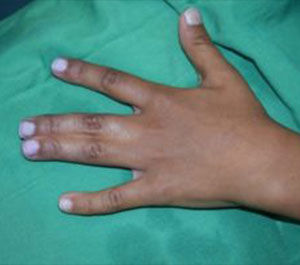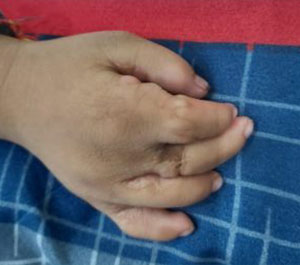Congenital, Birth Deformity
Syndactyly
The child is born with two or more fingers fused into one mass. This is called syndactyly. The aim is to separate these fingers into their independent and individual entities. At times all the fingers are fused into one single mass. The aim is separation of the fingers. It should be borne in mind that two adjacent digits are not equal in length. Hence the probability of the fingers deforming further is higher. Surgery is undertaken to separate them and prevent further deformity. It should be done very early in life.
Case Study

Syndactyly Case Study 1
The surgery involves, creating a web so that the two fingers are separated by a U and not a V, creating a nice nail fold.

Syndactyly Case Study 2
Fingers are joint since birth. One year after surgical separation of fingers and creating normalcy.
Absent Thumb
The infant was born without the thumb. The thumb was reconstructed by transferring the index finger in place of the thumb. Reconstructed thumb offers a better use of the hand as the new thumb is strategically better placed and more useful in holding objects.
Though the no. of digit remains at 4, but a finger after transfer to the location of the thumb significantly enhances the total hand function. The surgery was done when the child was less than 1 year old. The follow up is after 15 years. This procedure is called pollicisation.
The parents sometimes ask if it is possible to fix a thumb of someone else like you fix heart and kidney.
The short answer is No. It is best done when the child is about 1 year old as the brain integrates the new location of the thumb better.

Case Study
Camptodactyly
The finger is bent at its middle joint (Proximal inter phalangeal joint). It may be since birth or develops in early childhood. The treatment is non- surgical or surgical. In the nonsurgical treatment, the patient wears a dynamic splint to gradually correct the deformity.
It is a very slow process but does help to some extent and prevents progression. Surgery consist of releasing the offending structures.



Polydactyly
The mother and the daughter had similar deformity. The mother did not seek treatment but brought the daughter for surgery.
The aim of the surgery is to remove the extra digit, recreate the balance in the joint (Transfer the collateral ligament) by taking some tissue from the digit which is to be excised, and transfer of the tendon if needed.
Polydactyly & Duplicate thumb
The aim of the treatment is to create one single normal-looking thumb. This kind of duplication may be at the level of the terminal bone-like shown here or more proximally. At times it may involve the joint as well.
Spoon Hand
This complex deformity requires staged surgery to separate these fingers
- Creating a web so that the two fingers are separated by a U and not a V.
- Creating a nice nail fold.
- To prevent fingers contracting due to skin deficiency


Central Defect
The central finger is missing and the first web is narrower.
The surgery entails: Shifting the index finger in such way to increase the first web space, and reduce the central wide space.
Floating Thumb
This is a severe type of thumb mal development. The thumb is poorly developed. It has no bone, no tendon and is hanging like a pendulum. Any effort at trying to save it is futile, as it has no representation in the brain and hence does not work. The best strategy is to transfer the index finger and create a new thumb (Pollicisation).
If the parents insist than we fix the floating thumb and make it sturdier but it stands out but does not serve any useful purpose and does not participate in the act of holding objects.




